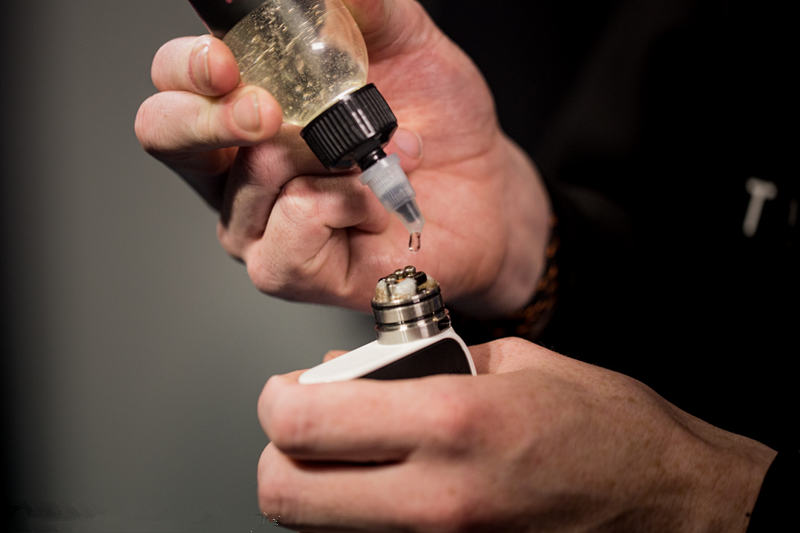
Nowadays most of the e-liquids are manufactured with the use of tobacco nicotine, however, scientists can now produce pure nicotine without the use of tobacco in the laboratory environment.
Synthetic/non-tobacco nicotine is not obtained from tobacco leaves, stems, tobacco extract or post-production tobacco waste. Synthetic nicotine/tobacco-free nicotine is an artificial replica of traditional nicotine derived from tobacco, but it is manufactured using chemicals that do not contain any tobacco plants.

What are the benefits?
First of all let's start with my favorite part, what are the benefits and why is it not only safer but over all better than regular nicotine most brands use.
– Dramatically reduced odor and harshness profile.
– The flavor takes the center stage.
– Base starter material is not derived from tobacco.
– All ingredients purchased from accredited suppliers.
– Manufactured to exceed USP and EP Grade requirements.
– Verifiable synthetic ‘S’ and ‘R-S’ nicotine signatures.
– Same satisfaction for adult smokers as other nicotine.
– Dramatically reduced odor and harshness profile.
What is Tobacco nicotine?

Nicotine is a molecule, alkaloid, naturally produced by some Solanaceae, a family that not only comprises tobacco but also chili peppers, tomatoes, potatoes, eggplants or petunia. Among those plants, tobacco (Nicotiana tabacum) is the one of the richest in nicotine with 8 to 14%, and it is the reason why it has been used, dried, and combusted in cigarettes.

Nicotine and tobacco have gone hand in hand for more than a hundred of years. When smoked nicotine causes psychological stimulus for smokers which makes it addictive. In combusted cigarettes, tobacco leaves have primarily been used without any other treatment than drying. Bright tobacco leaf are ready for harvest when they turn yellow-green, their sugar content is at its maximum and they will cure to a deep golden color with mild taste. Tobacco companies have worked on this taste with additives, whose controversial use is regarded as an enhancer of cigarettes’ addictiveness.
Nicotine has also been used as an insecticide after WWII but its use has declined since other cheaper molecules became available from the chemical engineering industry.
Liquid nicotine extracted from plants
In e-liquids, one no longer uses infused leaves of tobacco but rather a solution of liquid nicotine, a product that is generally obtained from tobacco leaves.

Nicotine levorotatory (S) and detrorotatory (R) enantiomers
Nicotine, 3-[1-Methylpyrrolidin-2-yl]pyridine, contains what chemists call a chiral carbon. Such molecules usually have two non-superposable structures, called enantiomers. They have the same chemical formula but the position of their atoms can differ and make the two molecules non superposable, like the right and left hands; mirror images of each other or enantiomers. In chemistry, the two enantiomers are the S- and R-nicotine.
S- and R- nicotine can be distinguished optically because S-nicotine rotates plane-polarized light to the left (levorotatory) and R- to the right (dextrorotatory). Last basic notion of stereochemistry, a mixture where the two enantiomers co-exist in a 1:1 ratio is termed racemic (the deviation of plane-polarized light is zero). In the case of nicotine, the racemic mixture would be termed RS-nicotine.

Alkaloids extraction is achieved from crushed crops with organic solvents and distillation. Nicotine and the alkaloids are soluble in solvents such as alcohol, chloroform, ether, petroleum ether, kerosene, and water. Micro-wave heating and mixtures of solvents can be used to increase nicotine extract yield and reduce extraction time and its purity is guaranteed to reach pharmaceutic grade, 99.9%.
Another method utilizes salt processing and turn the liquid into a sulfate salt. Such method requires a bleaching agent to get rid of the impurities. The sulfate salt is then turned back into a useable form with a reagent. Bleached liquids appear to be clearer and are wrongly thought of higher purity.
What is tobacco-free nicotine?
The reason why tobacco leaves, and not eggplants or potatoes, are used to obtain nicotine is because of their high content in nicotine and more precisely in S-nicotine, the active enantiomer.
Tobacco-free nicotine could be defined as the S-nicotine extracted from other species than N. tabacum. Nicotine extract yield and extraction time depend on the plant that is chosen.
By definition, synthetic nicotine is manufactured with the use of such chemical substances like, among others: ethanol, niacin, sulphuric acid. Some of the advantages that synthetic nicotine has over tobacco nicotine are the result of the low quality pure nicotine that is available on the market. Comparing to Chemnovatic’s PureNic 99+, synthetic nicotine has very similar properties and quality, so the only advantages, in this case, are the result of the synthetic nature of this product. Both PureNic 99+ and tobacco-free nicotine do not contain nitrosamines that might be present during the extraction of nicotine from tobacco.
Nitrosamines extracted from tobacco can still have a grain of plant, which creates unpleasant flavours and harshness. E-liquid manufacturers that use poor quality tobacco nicotine mask them with sweeteners and intensive flavours.
Chemical synthesis of nicotine

Nicotine has been a synthetic challenge to the chemist. Until recently [2]. The downside of synthetic nicotine is cost, and the most economical way to obtain the desired enantiomer of nicotine is via the resolution of a racemic mixture (RS-nicotine). Another step, re-crystallization, would allow to select the desired enantiomer (e.g. S-) and produce S-nicotine.
The main issue with racemic mixtures is that the presence of 50% of non-psychoactive R-nicotine and of 50% of psychoactive S-nicotine divides the potential activity of the juice by two compared to that crafted with natural tobacco extracts.
Since labels only show nicotine content, a racemic mixture of synthetic nicotine with strength of 10 mg/ml would in fact correspond to a juice of 5 mg/ml.
The liquid, when freshly synthesized is colourless, so is the nicotine extracted from tobacco leaves, after purification. The brownish coloration of liquid nicotine is a natural process that is produced upon exposure to light, heat and oxygen; sometimes it also occurs in the dark with time, even in sealed bottles. Nicotine coloration is purely “cosmetic” and clearer liquids do not imply a purer or higher quality.
